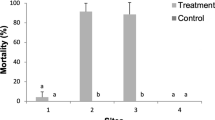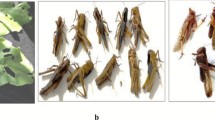Abstract
The susceptibility of larvae of the leek moth, Acrolepiopsis assectella Zeller (Lepidoptera: Acrolepiidae) to different concentrations of an autochthonous strain of Steinernema feltiae (Rhabditida: Steinernematidae) was examined in laboratory experiments using Petri dishes. The efficacy of this strain in pots and field experiments was also evaluated. High mortality (80%–100%) of leek moth larvae was observed when these larvae were exposed to low concentrations (3 × 103 to 1 × 104 IJs/m2) of S. feltiae under laboratory conditions. Foliar application of 30,000 IJs/leek in pot experiments caused a 98% reduction in leek moth larvae. Field experiments showed a 87.7% reduction of leek moth larvae with the nematode treatment, significantly higher than the 22% reduction with the Bacillus thuringiensis treatment. The efficacy of the treatments with S. feltiae in relation to the microhabitat of the leek moth larvae between the interfolded leaves of the leek is discussed.
Similar content being viewed by others
References
Abbott WS (1925) A method of computing effectiveness of an insecticide. J Econ Entomol 18:265–267
Arthurs S, Heinz KM, Prasifka JR (2004) An analysis of using entomopathogenic nematodes against above-ground pest. Bull Entomol Res 94:297–306
Asman K (2002) Trap cropping effect on oviposition behaviour of the leek moth Acrolepiopsis assectella and the diamondback moth Plutella xylostella. Entomol Exp Appl 105(2/3):153–164
Bari MA, Kaya HK (1984) Evaluation of the entomogenous nematodes Neoaplectana carpocapsae (=Steinernema feltiae) Weiser (Rhabditida: Steinernematidae) and the bacterium Bacillus thuringiensis Berliner var kurstaki for suppression of the artichoke plume moth (Lepidoptera: Pterophoridae). J Econ Entomol 77:225–229
Bélair G, Wright DJ, Curto G (2005) Vegetable and tuber crop applications. In: Nematodes as Biological Agents. Grewal PS, Ehlers RU, Shapiro-Ilan DI (eds) CABI Publishing, London UK, pp 255–264
Bélair G, Vincent C, Chouinard G (1998) Foliar spray with Steinernema carpocapsae against early-season apple pest. J Nematol 30:599–606
Boscher J (1983) Effect of the phytophage Acrolepiopsis assectella Zell. on the foliar demography of Allium porrum L. Acta Oecol Oecol Planta 4(4):335–344
Goix J (1986) The leek tineid. Phytoma 379:37
Greenwood P, Halstead A (1997) Pest and Diseases. Dorling Kindersley, London
Grewal PS, Georgis R (1998) Entomopathogenic nematodes. In: Hall F.R., Menn JJ. (eds) Biopesticides: Use and Delivery. Humana Press, Totowa, New Jersey, pp 271–299
Hara AH, Kaya HK, Gaugler R, Lebeck LM, Mello CL (1993) Entomopathogenic nematodes for biological control of the leafminer, Liriomyza trifolii (Diptera: Agromyzidae). Entomophaga 38:359–369
Head J, Walters KFA (2003) Augmentation biological control utilising the entomopathogenic nematode, Steinernema feltiae, against the South American leafminer, Lyriomyza huidobrensis. Proceeding of the 1st International Symposium on Biological Control (Hawaii, USA, 13–18 January 2002). USDA Forest Service, FHTET-03–05, pp 136–140
Hommes M (1992) Simple control thresholds for foliage pests of leek. Bull OILB SROP 15(4):115–121
Isart J, Frerot B, Chichon FM (1982) First test of control by mating disruption against the leek moth: Acrolepiopsis assectella (Zeller) in the Barcelona region. Les médiateurs chimiques agissant sur le comportement des insectes. Symposium international. Versailles, 16–20 novembre 1981.pp 373–387
Kaya HK, Gaugler R (1993) Entomopathogenic nematodes. Annu Rev Entomol 38:181–206
Kaya HK, Hara AH, Reardon RC (1981) Laboratory and field evaluation of Neoaplectana carpocapsae (Rhabditida: Steinernematidae) against the Elm Leaf Beetle (Coleoptera: Chrysomelidae) and the Western Spruce Budworm (Lepidoptera: Tortricidae). Canadian Entomol 113(9):787–793
Laumond C, Mauléon H, Kermarrec A (1979) Données nouvelles sur le spectre d’hôtes et le parasitisme du nématode entomophage Neoaplectana carpocapsae. Entomophaga 24(1):13–27
Legutowska H, Plaskota E (1986) Influence des conditions d’environment et de culture sur deux ravageurs des plantes maraicherères : la mouche de la carotte Psila rosae Fab. Et la teigne du poireau Acrolepiopsis assectella. In: Impacts de la structure des paysages agricoles sur la protection des cultures, Poznan, 9–14 Septembre, 1985. Ed. by INRA, Paris : Les Colloque de l’INRA 36, 61–73
Lorenz N, Zimmermann O, Hassan SA (2003) Use of Trochogramma parasitoids against the leek moth (Acrolepiopsis assectella, Lep. Plutellidae) for the solution of plant protection problems in organic farming. DGaaE Nachrichten 1:19
Mason JM, Wright DJ (1997) Potential of the control of Plutella xylostella larvae with entomopathogenic nematodes. J Invertebr Pathol 70:234–242
Minks AK, Voerman S, Theunissen J (1994) Improved sex attractant for the leek moth, Acrolepiopsis assectella Zell. (Lep., Acrolepiidae). J Appl Entomol 117(3):243–247
Nyrop J, Shelton A, Theunissen J (1989) Value of a control decision rule for leek moth infestation in leek. Entomol Exp Appl 53:167–176
Plaskota E, Dabrowski ZT (1986) Biological principles of leek moth (Acrolepia assectella Zeller, Lepidoptera: Plutellidae) control. 1. Host plants damage caused by leek moth larvae and leek moth parasites. Ann Warsew Agric Univ SGGW-AR Hortic 13:27–34
Rahn R (1982) Sex-pheromone trapping of the leek moth, Acrolepiopsis assectella Z. (Lepid. Yponomeutidae - Acrolepiinae) using Z 11 H DAL. Results of the 1981 programme. Agronomie 2(10):957–962
Smart GC (1995) Entomopathogenic nematodes for the biological control of insect. J Nematol 27(4S):529–534
Thibout E (1988) The specificity of Diadromus pulchellus (Hymenoptera: Ichneumonidae) towards its host Acrolepiopsis assectella, the leek moth. Entomophaga 33(4):439–452
White GF (1927) A method for obtaining infective nematode larvae from cultures. Science 66:302–303
Woodring JL, Kaya HK (1988) Steinernematid and heterorhabditid nematodes: A handbook of techniques. South Co-operative Serv Bull 331:1–30
Zimmermann O (2004) Use of Tricogramma wasp in Germany: present status of research and commercial application of egg parasitoids against lepidopterous pest for crop and storage protection. Gesunde Pflanzen 56(6):157–166
Acknowledgements
We thank Ricard Sorribes of the Plant Protection Service of the Agricultural Department of the Catalan Government for his technical support in the field experiments and we also thank Mark Burch for the English correction of the manuscript.
Author information
Authors and Affiliations
Corresponding author
Rights and permissions
About this article
Cite this article
García del Pino, F., Morton, A. Efficacy of Steinernema feltiae against the leek moth Acrolepiopsis assectella in laboratory and field conditions. BioControl 53, 643–650 (2008). https://doi.org/10.1007/s10526-007-9106-0
Received:
Accepted:
Published:
Issue Date:
DOI: https://doi.org/10.1007/s10526-007-9106-0




